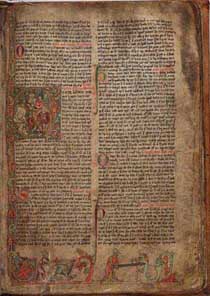 WEMSK17:Textual Criticism
WEMSK17:Textual Criticism
 WEMSK17:Textual Criticism
WEMSK17:Textual Criticism
WEMSK17 -- Textual Criticism
It is somewhat difficult to distinguish between Textual Criticism,
Editing Technique, Palaeography and Codicology, so WEMSK17-20 will
be devoted to these four subjects. If you do not find Staehlin
under Textual Criticism, don't worry; it will be under Editing.
Thematic and technical analysis -- this seldom practised art -- is
the only adequate means of interpretating an author, as such the
Vorschule of all literary criticism, if it wishes to lift itself
above talking, talking around, talking past.
A book is, above all else, a "text." You understand it or you do
not understand it. It contains "difficult" passages. You need a
technique to interpret them. It is called Philology. Since the
study of literature deals with texts, it is helpless without
philology. -- Ernst Robert Curtius, 1947.
Textual Criticism
[For general bibliography: David Greetham, "Selected Bibliography,"
in his Textual Scholarship: An Introduction (NY: Garland, 1994),
419-526]
1. To see what we are talking about: Paul Maas, Textkritik, 3d ed.,
verbesserte und vermehrte Auflage (Leipzig: Teubner, 1957). There
is an English translation: Textual Criticism, transl. Barbara
Flower (Oxford: Clarendon Press, 1958, reprinted 1967). Just read
it through; it is not a look-up book. It presents standard
Lachmaann (dendrological) procedures, espoused by most people.
2. Many people suggest that the following may be a better
introduction: Martin L. West, Textual Criticism and Editorial
Technique applicable to Greek and Latin Texts (Stuttgart: Teubner,
1973). It is a little larger and less lapidary than Maas, but
I
like Maas.
3. Still the most common method used is the dendrological (texts as
genealogical trees). Cf. Sebastiano Timpanaro, La genesi del
metodo del Lachmann, Biblioteca di cultura. Sezione letteraria. New
and expanded edition (Padua: Liviana, 1981). You might prefer:
Harald Weigel, Nur was du nie gesehn wird ewig dauern: Carl
Lachmann und die Entstehung der wissenschaftlichen Edition. 1.
Aufl. (Freiburg: Rombach, 1989). For a more general expose of the
genealogical method in a number of disciplines: Henry M.
Hoenigswald and L. F. Wiener, eds., Biological Metaphor and
Cladistic Classification: An Interdisciplinary Perspective.
(Philadelphia: University of Pennsylvania Press, 1987).
4. The genealogical method came under attack from a number of
angles along about 1900, particularly from Bedier, who wondered if
the bifurcation he observed in most of the stemmata was the fault
of the material or the method. Cf. Joseph Bedier, "La tradition
manuscrit du `Lai de l'ombre': R‚flexions sur l'art d'‚diter les
anciens texts." Romania 54 (1928): 161-96, 321-56; Frederick
Whitehead and Cedric E. Pickford, "The Introduction to the Lai
de
l'ombre: Sixty Years Later." Romania 94 (1973): 145-56. This led
many people to espouse the idea of the Leithandschrift.
5. Dissatisfaction with the personal nature of textual criticism,
with various examples of bias, led critics to attempt numerical
taxonomy, where the groupings of manuscripts were done by an
impersonal algorithm. Cf. Henri Quentin, Essais de critique
textuelle (Ecdotique) (Paris: A. Picard, 1926). A strong proponent
is Jacques Froger, La critique des textes et son automatisation.
Initiation aux nouveautes de la science, 7 (Paris, 1968).
6. The genealogical method was attacked from another quarter by E.
C. Colwell, who pointed out that it works only when there is a
paucity of evidence. Colwell's dilemma: The more evidence you
have
the worse the method works. Cf. his, "Genealogical Method: Its
Achievements and its Limitations," Journal of Biblical Literature
19 (1947), 109-133.
7. The old notion of a "zeilengetreue" edition, such as that of
Uppstroem for texts of the Gothic Bible, has resurfaced with the
advent of the computer and new printing methods; cf. Hans Fix,
"Production and Usage of a Machine-Readable Manuscript: A Report on
the Saarbruecken Verson of Gragas Konungsbok," Computer
Applications to Medieval Studies, ed. Anne Gilmour-Bryson. Studies
in Medieval Culture XVII (Kalamazoo, 1984), 107-116.
8. Of course, we should always keep in mind the possibility of
photographing our manuscripts and presenting them in various
enhanced forms, exemplified by the Beowulf and Piers Plowman from
Michigan. On the various methods of photography and registration,
see Marchand, "The Computer as Camera and Darkroom," in Medtextl's
archives and Religious Studies News 7, 2 (March 1992) and CSSR
Bulletin 21, 2 (April 1992). Methods of making facsimiles are
discussed on a later WEMSK.
9. For the various problems one encounters in the text itself (such
as dittography, haplography, etc.), see the excellent discussion in
F. W. Hall, Companion to Classical Texts (Oxford: OUP, 1913), 198-
198. For exemplification of these in a specific text: James W.
Marchand, The Sounds and Phonemes of Wulfila's Gothic (The Hague:
Mouton, 1973).
10. On textology, the best book is: D. S. Likhachev, Tekstologiya
(Moscow and Leningrad: Akademiya Nauk, 1962). If you cannot read
Russian, see the extended review in Probleme altgermanistischer
Editionen. Forschungsberichte 14 (Wiesbaden: Steiner, 1968), 169-
180, by Werner Alberts.
11. There are several books which have gathered articles on the
subject, for example:
a. Christopher Kleinhenz, ed., Medieval Manuscripts and Textual
Criticism. North Carolina Studies in the Romance and Languages and
Literatures, Symposia IV. Chapel Hill: Department of Romance
Languages. University of North Carolina, 1976.
b. Juergen Dummer, et al., Texte und Textkritik: eine
Aufsatzsammlung (Berlin: Akademie-Verlag, 1987).
12. Descriptive bibliography:
a. Ronald B. McKerrow, An Introduction to Bibliography for Literary
Students. 2d impression with corrections (Oxford: OUP, 1928).
For
years the standard work on "descriptive bibliography."
b. Philip Gaskell, A New Introduction to Bibliography. Oxford:
OUP, 1972. A failed attempt to replace McKerrow, but still good.
c. John Bush Jones, Readings in Descriptive Bibliography (Kent
State University Press, 1974). A good set of readings.
13. On textual emendation: Eugene Vinaver, "Principles of Textual
Emendation." Studies in French Language and Mediaeval Literature
Presented to Professor Mildred K. Pope. Publications of the
University of Manchester, no. cclxviii. Manchester: Manchester
University Press, 1939. A good statement of a bad practice.